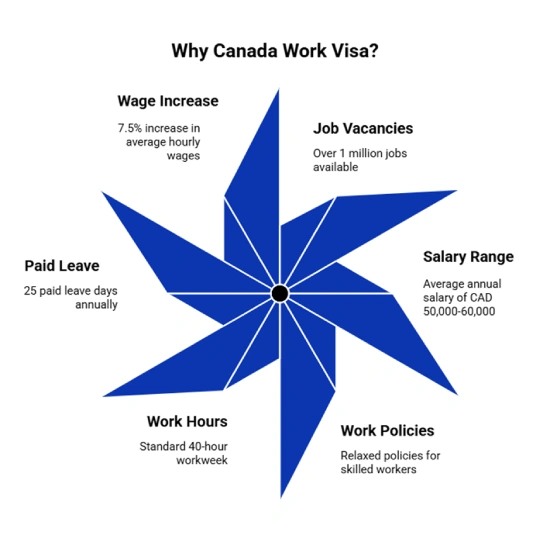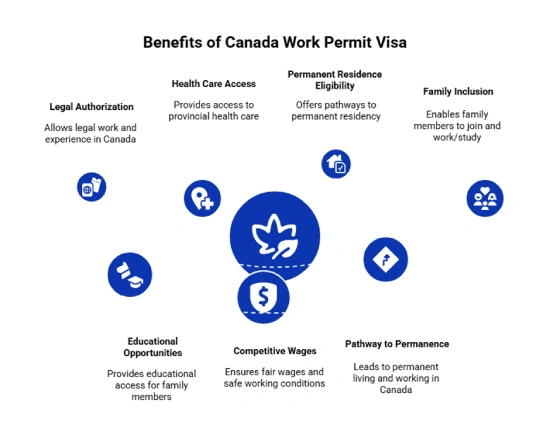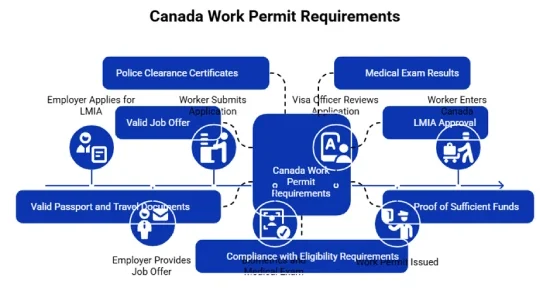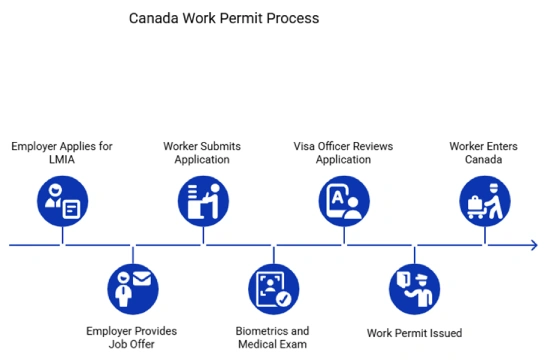Canada work visa allows foreign nationals to legally work in Canada, providing opportunities for skilled professionals, temporary workers, and international students. It serves as a pathway to gain valuable Canadian work experience and can lead to permanent residency. Each year, Canada issues hundreds of thousands of work permits, supporting its diverse and growing labor market. The visa process involves obtaining a job offer, sometimes requiring a Labour Market Impact Assessment (LMIA), and meeting eligibility criteria set by the Canadian government.

A Canada work permit is a legal document issued by Immigration, Refugees and Citizenship Canada (IRCC) that authorizes foreign nationals to work legally in Canada for a specified period. It is distinct from a visa, which allows entry into Canada; a work permit specifically grants employment authorization. There are two main types: employer-specific work permits, which tie the worker to a particular employer, and open work permits, which allow work for any eligible employer in Canada. Work permits are typically temporary but can often be extended or serve as a stepping stone to permanent residency.
Holding a Canada work permit visa offers numerous benefits:

Australia is one of the key source countries for Canada work visa applicants. In 2022, Canada issued over 60,000 work permits to Indian nationals, reflecting strong demand for skilled Indian workers in sectors like IT, healthcare, and engineering. Indian applicants benefit from various immigration programs, including the Temporary Foreign Worker Program and the Post-Graduation Work Permit for international students who graduate from Canadian institutions. The availability of employer-specific and open work permits provides flexible options for skilled workers seeking employment in Canada.
*Searching for jobs in Canada? Find the right one with the help of Y-Axis job search services.
To apply for a Canada work permit, applicants must meet several eligibility requirements:

Most foreign nationals require a work permit to work in Canada, but some are exempt under specific categories such as international students, spouses of work permit holders, or those covered by free trade agreements. Eligibility depends on factors including:
The process to obtain a Canada work permit generally involves:
Step 1: Employer applies for a Labour Market Impact Assessment (LMIA) if required.
Step 2: Employer provides a job offer letter and LMIA approval to the foreign worker.
Step 3: Foreign worker submits a work permit application online or at a visa application center with documents required.
Step 4: Biometrics and medical exam are completed if necessary.
Step 5: Visa officer reviews the application and issues a temporary resident visa or electronic travel authorization if required.
Step 6: Work permit is issued at the port of entry or mailed if applying from inside Canada.
Step 7: Worker enters Canada and begins employment under the conditions of the permit.

Processing times vary depending on the type of work permit, country of application, and completeness of documents. On average:
The fees for Canada work permits include:
Canada offers numerous job opportunities for Indian workers, particularly in sectors experiencing labor shortages:
Canada issues several types of work permits:
The Labour Market Impact Assessment (LMIA) is a document issued by Employment and Social Development Canada (ESDC) that verifies there is a need for a foreign worker and no Canadian citizen or permanent resident is available to do the job. Employers must obtain a positive LMIA before hiring most foreign workers. The LMIA process involves recruitment efforts and assessing the impact on the Canadian labor market. Some work permits are LMIA-exempt under international agreements or specific categories.
An open work permit allows foreign nationals to work for any eligible employer in Canada without the need for a job offer or LMIA. Common recipients include:
Y-Axis is a leading immigration and visa consultancy that specializes in assisting individuals with their Canada work visa applications. With expert guidance and personalized support, Y-Axis helps simplify the complex process of obtaining a Canadian work permit, ensuring a smooth and successful application experience.
Our services include:
With Y-Axis, you gain access to experienced professionals dedicated to helping you work in Canada legally and efficiently.
Explore what Global Citizens have to say about Y-Axis in shaping their future
Australia Skill Stream Visa
Aman Maan, Australia Skill Stream Visa.
Read More...
Australia Skill Stream Visa
Faisal Shah gave a feedback after receiv
Read More...
Australia Skill Stream Visa
Divya Vaidyanathan gave a feedback after
Read More...
Yes, most foreign nationals can obtain a Canada work visa, also known as a work permit, to legally work in Canada. Eligibility depends on factors such as having a valid job offer from a Canadian employer, meeting health and security requirements, and sometimes obtaining a Labour Market Impact Assessment (LMIA). Some categories, like spouses of work permit holders or international graduates, may qualify for open work permits without a job offer. The work visa allows temporary employment and can be a pathway to permanent residency.
To apply for a Canada work visa, you generally need a job offer from a Canadian employer. The employer may need to obtain an LMIA to prove no Canadian worker is available for the job. After securing the job offer and LMIA (if required), you submit an application online or at a visa application center with the necessary documents, including proof of identity, job offer letter, and police clearance certificates. Biometrics and medical exams may also be required. Processing times vary, and you can track your application through your online account.
The Canada work visa process starts with obtaining a job offer from a Canadian employer. If required, the employer applies for a Labour Market Impact Assessment (LMIA). Once approved, the foreign worker submits a work permit application online or at a visa center, including documents like the job offer letter, LMIA, and proof of identity. Applicants may need to provide biometrics and undergo a medical exam. After the visa officer reviews the application, a temporary resident visa or electronic travel authorization may be issued, followed by the work permit upon arrival or by mail if applying from inside Canada.
The cost to apply for a Canada work visa includes a work permit application fee of CAD 155. If applying for an open work permit, an additional CAD 100 fee applies. Biometrics fees are CAD 85 per person. Medical exams vary by provider, usually ranging from CAD 100 to CAD 300. Police certificate fees depend on the issuing country and are non-refundable. These fees are payable regardless of the application outcome. Additional costs may include translation of documents and courier charges. Applicants should budget accordingly when applying for their Canada work visa.
A Canada work visa can serve as a pathway to permanent residency. Foreign workers who gain Canadian work experience through a valid work permit may qualify for permanent residence under programs such as the Canadian Experience Class (CEC) or Federal Skilled Worker Program (FSWP). Provincial Nominee Programs (PNP) also offer routes for workers in specific provinces. Applying for permanent residency requires meeting eligibility criteria, including language proficiency, work experience, and sometimes a job offer. Transitioning from a temporary work permit to permanent resident status is a common route for skilled foreign workers in Canada.
A Canada work visa generally refers to the overall authorization to work in Canada, which includes a work permit and, if necessary, a temporary resident visa or electronic travel authorization to enter Canada. The work permit is the actual legal document that allows foreign nationals to work in Canada for a specified employer or under an open permit. In some cases, a work permit alone is sufficient, but some applicants also need a visa or eTA to enter Canada. Understanding the difference is important for proper application and compliance with immigration rules.
To apply for a Canada work permit, applicants must have a valid job offer from a Canadian employer, meet health and security standards, and provide necessary documents such as a valid passport, police clearance certificates, and medical exam results if required. The employer may need to obtain a Labour Market Impact Assessment (LMIA) unless the position is LMIA-exempt. Applicants must also demonstrate sufficient funds to support themselves and intend to leave Canada at the end of their authorized stay unless applying for permanent residency. Meeting all eligibility requirements is essential for approval.
Certain categories of foreign nationals can apply for a Canada work visa without a job offer by obtaining an open work permit. This includes spouses or common law partners of skilled workers or international students, international graduates with a Post Graduation Work Permit, and participants in international mobility programs. Open work permits allow holders to work for any eligible employer in Canada, providing flexibility. Eligibility criteria and application processes vary, so applicants should carefully review requirements and submit all necessary documents to qualify for an open work permit without a specific job offer.
Holding a Canada work visa does not grant permanent residency (PR) directly, but it can be a step toward PR. Foreign workers with Canadian work experience gained through a valid work permit may apply for PR through programs like the Canadian Experience Class or Provincial Nominee Programs. These pathways consider factors such as work experience, language proficiency, and job offers. Applying for PR requires meeting program-specific criteria and submitting a separate application. Many foreign workers use their temporary work visa status as a foundation to establish permanent residency in Canada.
Australian citizens are eligible to apply for a Canada work visa under various programs, including employer-specific and open work permits. They may benefit from free trade agreements that exempt some work permits from requiring an LMIA, simplifying the process. Australians can apply online or at visa application centers, providing necessary documents like a job offer letter if applicable, police certificates, and medical exams. Some may qualify for International Experience Canada (IEC) permits, allowing young Australians to work and travel in Canada temporarily. Processing times and requirements vary by permit type.
Canada is in need of graduates who have recently completed their studies from universities, trades schools, and colleges. These students should be willing to live and work in Canada. They need to give a good contribution to the Canadian economy. Canada has a literacy rate of 99 percent, and 56 percent of its adult population has a tertiary qualification.
Following concepts can be involved in Canadian work experience:
Employers use the lack of Canadian work experience to eliminate the newcomers.
There is no need of any job offer to migrate to Canada and get a permanent resident visa. But you must know that employers in Canada play a crucial role in Canadian immigration through federal Express Entry selection system. If you will be able to obtain a Canadian job offer, your chances of getting the permanent residence visa will increase.
There are two types of job offers that Canadian employers provide, and these include temporary job offers and permanent job offers. The temporary job offer is given for a fixed period which can be six months, one year, etc.
The individuals will have to obtain a temporary work permit to work in Canada. There is no time limit for a permanent job offer. Individuals have to go for Canada Immigration visa to start working.
Yes, it is possible to get temporary work permit and Canada Immigration. Individuals have the option of getting a temporary work permit in combination with a Canada immigration visa. IRCC recognizes dual intent in which applicants want to work temporarily and then work and reside in Canada permanently.
If the candidates are able to get a job offer, which is supported by LMIA, then they will get the CRS score of 50 or 200 points. These points are given on the basis of the type of job offer given to the candidates. These points are not a guarantee to get the opportunity to apply for permanent residence but they will get the chance of invitation to apply.
The benefits of getting the temporary job offer are as follows:
The work permit is needed by those people who are not Canadian citizens or permanent residents of Canada. Foreign workers also have the option to do some of the jobs without having a work permit.
Applicants have the option of applying online for getting a work permit. Applicants need to send the electronic copies of the requirements so they must have a camera or a scanner. Besides uploading the documents, a copy of credit card should also be scanned and uploaded.
Individuals also have the option to apply for work permit from outside Canada. They need to go to a Canadian visa office that has the responsibility of the citizenship of the applicants.
The processing time of the work permits can be a few days to a few weeks. The processing time depends on workload at a visa office or the requirement for the medical examination.
The information about jobs in Canada can be found on the job banks, labour market information, and the working in Canada tool.
The processing time of the work permit varies and it depends upon the type of applications. An average processing time for the applications ranges between 1 and 9 months. The factors on which the processing time depends include
The type of application submitted
If your work permit is still valid, you can extend your permit from inside Canada. The application has to be sent at least 30 days before the expiry of the current work permit. If you apply for the extension of your current work permit, you will be allowed to stay in Canada till the time your application is processed.
A job offer letter is given by Canadian employers to the applicants. The offer letter includes the details of the job. It is also a contract between the Canadian employers and the applicants. The following information is included in the offer letter: